Truly terrific this year – the turn out at The Las Vegas National was super, competition fierce and in Vegas there is certainly no lack of extracurricular activities. At the South Point alone you can go to the movies, bowl, visit the spa, dine in one of nine restaurants and of course gamble. And your horse is on the premises!
Featuring several savory equestrian evenings, the event served up some great show jumping, exciting until the last rider.
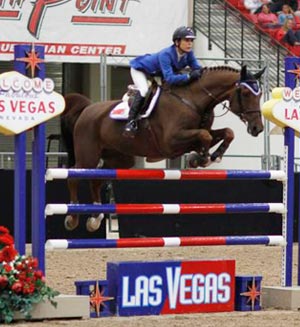
and Taunus
Steinwedell-Carvin Gives Up Control
When twenty-nine horse and rider combinations competed in a one round competition against the clock in the $31,000 Las Vegas National Welcome Jumper Classic, presented by Summit General Insurance Agency, Francie Steinwedell-Carvin and Taunus were top notch. Eleventh to go, Steinwedell-Carvin and Prentiss Partner’s Taunus set a solid time, clean in 60.25, and held their lead through the next eighteen attempts.
Steinwedell-Carvin shared how her relationship with Taunus has blossomed of late, as she had an experience that taught her to “‘give up control to get control.’ He likes to go around on the flat with his head up and I would work so hard to get him to get round.” After working with a horse in a western saddle in a round pen with a cowboy, Francie learned about giving up control.
“A light came on without me realizing it, I had a transition of trust that I could let go. I relaxed so he relaxed and it worked.”
A difficult aspect to give up while negotiating a course of big jumps and tight turns – control – finding that synchronicity is a constant challenge. How an experienced rider learns new ways to communicate is an interesting question. Ask someone you admire about an unexpected experience that led to success in the show ring.
Good to the Last Draw
On a chilly evening in the Vegas desert the South Point Equestrian arena was on fire as twenty-nine horse and rider combinations hailing from all over the world raced for the win in the $20,000 1.35m Speed Classic, presented by CardFlex. Previous to this fast and furious event, the kids had a ton of fun at the JustWorld International Horseless Horse Show and the precious leadliners stole the crowd’s heart.
The track created by course designer Anthony D’Ambrosio offered several options for speed, and riders picked a variety of tracks for success. First to go American Karl Cook set the pace aboard Signe Ostby’s Notories Utopia. The ride was smooth and slick in a time of 61.44. D’Ambrosio commented, “Karl is going to be tough to beat. There are two places where you could do one less stride than he did, that may be the only way to win.”
Per his prediction, try as they might, rider after rider nipped at Karl’s heels but none could catch him. The ultimate thrill of the evening came with the final ride, Argentinean Eduardo Braun on H.J. El Magnifico. Just when the crowd figured Cook had it in the bag, Braun sped his way through the track with style and stopped the clock in 61.10, just over three tenths of a second faster than Cook for the win. The crowd went crazy as Braun raised his fist in victory.
Saturday Night Lights & Heights
Saturday was super at the Las Vegas National. The evening began by crowning a champion in the PCHA Victor Hugo-Vidal Adult Medal Finals. In its first year at this indoor location, three riders finished the first two rounds within three percentage points of each other and returned for a work-off. Called in second, Lorri Quiett on Abigail performed well and ultimately earned the top spot.
Next Karl Cook illustrated that speed pays off in the exciting $10,000 Winning Round Classic, presented by Royal Champion. Twenty-seven couples gave it a go and nine completed the course fault free. Unique to the Winning Round Format, riders return according to their score and time in the first round.
Since all were clean, time determined the order of go in the second round. It was no surprise that Karl Cook and Jonkheer Z (Signe Ostby, owner) were the last to come back in the second round. Shaving almost two seconds off Kirsten Coe and Vernon G’s leading time, Cook took the win at the last second.
Commencing with a rockin’ light show, followed by a Parade of Nations with an introduction of each grand prix rider, the crowd was ready for some superb show jumping. Before the four-hooved types galloped in, kids large and small leaped up to 1.20m in the JustWorld International High Jump competition.
The twenty-four entries in the $50,000 Last Vegas National Grand Prix, presented by Summit General Insurance Agency, were a balance of eleven male and ten female competitors representing six nations. Course designer Anthony D’Ambrosio set an ‘up to standard’ 1.60m track with spreads up to 1.65m, a triple bar at 1.90m, a triple combination with two oxers and a delicate 1.60m skinny vertical. Over half the class rose to the occasion, with eight moving on to the jump-off round and five scored just four faults.
Double clears included American John McConnell aboard Rancho Corazon’s Katie Riddle, who sailed smoothly around the shortened course clean in 40.57, taking the lead. A short-lived lead however, as the young and quick Karl Cook on ASB Conquistador (Signe Ostby, owner) followed with another double clean effort in 38.56. The petite Danish rider Emilie Martinsen rode the powerful Toscane well (J.a.j Van Rijiswijk, owner), finishing double clean in 45.16 earning a respectable fourth place. Last but certainly not least, Brazilian Eduardo Menezes entered on Francisco Pasquel’s Calavda. He had this envious position in 2010 as well and won. On a horse he’d only been riding a few months, Menezes was double clean, stopping the clock in 38.15, four tenths of a second faster than Cook for another sweet Vegas victory. The crowd went crazy as Menezes crossed the finish line. Once again the final ride clinched the top prize.
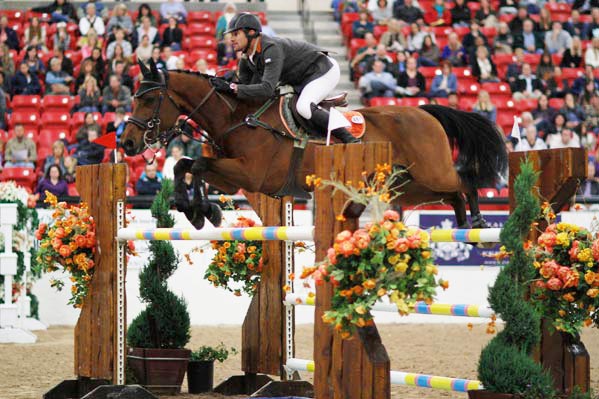
The Brazilian professional who resides in Mexico and California was especially pleased with his win, since this was his first grand prix on Calavda. When asked about the Vegas vibe, Menezes smiled and said, “I love this show, this venue. Vegas is like Disneyland for adults.”
 On Thursday evening of the Showpark All Seasons Summer Classic Blenheim EquiSports hosted the $30,000 Showpark Jumper Classic, presented by Royal Champion. With 42 entries, the event served as a warm-up for Saturday’s World Cup Qualifier as well as an opportunity to ride in the first indoor class of the California season. Scored as a speed class, eight pairs went clean, but fastest of the night were the new match of Jill Humphrey and Tao Tao 3 (Alicia Jonsson Foster, owner). Second place went to Richard Spooner and his partner Ace (S&B LLC, owner) with Keri Potter and Rockford I rounding out the top three.
On Thursday evening of the Showpark All Seasons Summer Classic Blenheim EquiSports hosted the $30,000 Showpark Jumper Classic, presented by Royal Champion. With 42 entries, the event served as a warm-up for Saturday’s World Cup Qualifier as well as an opportunity to ride in the first indoor class of the California season. Scored as a speed class, eight pairs went clean, but fastest of the night were the new match of Jill Humphrey and Tao Tao 3 (Alicia Jonsson Foster, owner). Second place went to Richard Spooner and his partner Ace (S&B LLC, owner) with Keri Potter and Rockford I rounding out the top three. D’Ambrosio presented the competitors with sixteen efforts. With some ‘delicate’ fences, D’Ambrosio wanted to test the accuracy of the entrants without too many demanding fences in a row. “I had one wide oxer in the triple combination and one in the double, but I didn’t have another difficult fence immediately follow either,” the American designer explained. Some riders lowered the height of the triple bar on course while others found trouble at various areas in the triple and double combinations, as well as fence 11, a daunting vertical jumped on a slight angle towards the grand stands.
D’Ambrosio presented the competitors with sixteen efforts. With some ‘delicate’ fences, D’Ambrosio wanted to test the accuracy of the entrants without too many demanding fences in a row. “I had one wide oxer in the triple combination and one in the double, but I didn’t have another difficult fence immediately follow either,” the American designer explained. Some riders lowered the height of the triple bar on course while others found trouble at various areas in the triple and double combinations, as well as fence 11, a daunting vertical jumped on a slight angle towards the grand stands.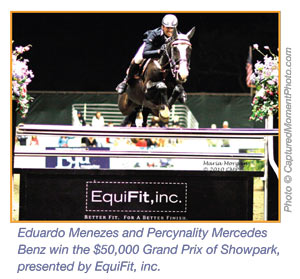 As the second rider to step up to the jump off challenge, Menezes knew he had to give it his all. “I had to be fast because Susie [Hutchison] and Karl [Cook] were behind me and they are quick,” the winner said. Jumping around clean in 36.87, Menezes clearly delivered as neither Hutchison nor Cook were fault-free. After having finished second in his share of grand prix events this season, Menezes was particularly happy. “When I felt him in the warm-up ring, I knew he was feeling great,” Menezes said of his 13-year-old partner.
As the second rider to step up to the jump off challenge, Menezes knew he had to give it his all. “I had to be fast because Susie [Hutchison] and Karl [Cook] were behind me and they are quick,” the winner said. Jumping around clean in 36.87, Menezes clearly delivered as neither Hutchison nor Cook were fault-free. After having finished second in his share of grand prix events this season, Menezes was particularly happy. “When I felt him in the warm-up ring, I knew he was feeling great,” Menezes said of his 13-year-old partner.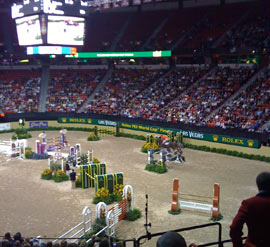 Walking the Table C course with Anthony D’Ambrosio on Thursday it was clear he set a course of many colors. The jumps were vibrant and the options he offered riders created a field with numerous tracks.
Walking the Table C course with Anthony D’Ambrosio on Thursday it was clear he set a course of many colors. The jumps were vibrant and the options he offered riders created a field with numerous tracks. Ultimately the class winner, Meredith Michaels-Beerbaum riding her partner Shutterfly, stopped the clock in 56.48. She chose the best track for her horse, which included tight turns and adding strides. “I thought it was a brilliant course,” said. “It presented a lot of options. I was surprised only one other rider (Steve Guerdat) did it the way I did.”
Ultimately the class winner, Meredith Michaels-Beerbaum riding her partner Shutterfly, stopped the clock in 56.48. She chose the best track for her horse, which included tight turns and adding strides. “I thought it was a brilliant course,” said. “It presented a lot of options. I was surprised only one other rider (Steve Guerdat) did it the way I did.”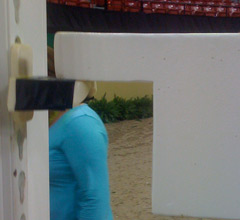 With 14 obstacles set, interesting questions asked included fence three the triple bar, 1.90m (6’3”) wide, 1.55m (5’1”) high at the back rail. The triple combination was the eighth obstacle, vertical-vertical-oxer, with a quick turn to 1.60m (5’3”) Las Vegas vertical in a steady five or potentially a forward four strides. Fence eleven was an airy wide oxer that caught a few horses, however the two jumps providing the most difficulty were the Las Vegas vertical at nine and the plank on flat cups at 12. As the plank was the first jump in a tough four or five stride line to a double right towards the in-gate. “Number nine came up quickly after the triple combination, and rode in a short distance toward the in-gate,” explained second place finisher McLain Ward at a press conference after the award presentation. “Planks are always tough, seemed some of the riders were riding the distance in the line after the jump before clearing it.”
With 14 obstacles set, interesting questions asked included fence three the triple bar, 1.90m (6’3”) wide, 1.55m (5’1”) high at the back rail. The triple combination was the eighth obstacle, vertical-vertical-oxer, with a quick turn to 1.60m (5’3”) Las Vegas vertical in a steady five or potentially a forward four strides. Fence eleven was an airy wide oxer that caught a few horses, however the two jumps providing the most difficulty were the Las Vegas vertical at nine and the plank on flat cups at 12. As the plank was the first jump in a tough four or five stride line to a double right towards the in-gate. “Number nine came up quickly after the triple combination, and rode in a short distance toward the in-gate,” explained second place finisher McLain Ward at a press conference after the award presentation. “Planks are always tough, seemed some of the riders were riding the distance in the line after the jump before clearing it.”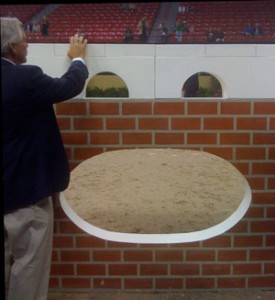 Mission accomplished – seventeen riders had just one rail, mostly at the jumps mentioned above. However thirteen of forty-two riders rode fault free. In an exciting jump-off, that demanded tidy turns and a long gallop to the final oxer, six went double clear.
Mission accomplished – seventeen riders had just one rail, mostly at the jumps mentioned above. However thirteen of forty-two riders rode fault free. In an exciting jump-off, that demanded tidy turns and a long gallop to the final oxer, six went double clear.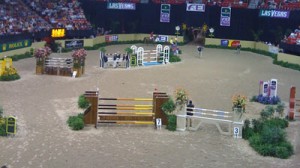 A day of rest for the World Cup horses, the Saturday course was built for the Las Vegas Grand Prix immediately followed by some of our nation’s best riders dropping britches for jeans, chaps and cowboy boots in a reining competition.
A day of rest for the World Cup horses, the Saturday course was built for the Las Vegas Grand Prix immediately followed by some of our nation’s best riders dropping britches for jeans, chaps and cowboy boots in a reining competition. Sunday is run in a format unique to the World Cup. Theplacings from the first two rounds are converted into World Cup penalty points to determine the overall ranking. With two rounds, the faults accumulated in the first round are added to the penalty points to determine who returns for the second round. A jump-off follows only if there is a tie after the two rounds are complete. The 22 riders with the lowest score, along with any with clean rounds who chose to ride again, moved on to the next round—which is also scored by adding faults incurred to the rider’s penalty points.
Sunday is run in a format unique to the World Cup. Theplacings from the first two rounds are converted into World Cup penalty points to determine the overall ranking. With two rounds, the faults accumulated in the first round are added to the penalty points to determine who returns for the second round. A jump-off follows only if there is a tie after the two rounds are complete. The 22 riders with the lowest score, along with any with clean rounds who chose to ride again, moved on to the next round—which is also scored by adding faults incurred to the rider’s penalty points. Round II
Round II